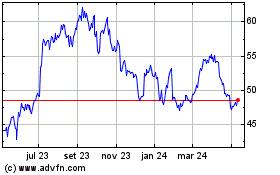BP To Cap Oil Spill With Drilling Fluid Early Next Week
21 Maio 2010 - 5:59PM
Dow Jones News
BP Plc (BP)'s effort to cap a massive deepwater oil spill using
heavy drilling fluids will be implemented early next week, an
executive said Friday.
The drilling fluid will be injected into the damaged well
"sometime early in the coming week," BP Chief Operating Officer
Doug Suttles said in a conference call. "Probably Tuesday." The
U.K.-based oil giant is working to put all the equipment into place
to perform the so-called "top-kill" operation, which includes a
"very large barge" filled with drilling "mud," Suttles said.
The executive said that the company it is siphoning an average
of 2,000 barrels of oil per day from the leaking well directly to a
vessel on the surface. The update comes a day after BP said that it
was collecting 5,000 barrels of oil a day, or as much crude as was
officially estimated to be gushing out of the mile-deep well. That
figure forced BP to admit that the leak is larger than previously
thought. Suttles said that the variation is due to wide
fluctuations in the rate of oil being captured.
Sharp criticism of BP's effort to control the spill spiked on
Thursday, as heavy patches of oil reached the Louisiana shore.
Federal officials criticized the company's inability to accurately
assess the estimate, and the Environmental Protection Agency
ordered the company to find a less toxic dispersant to break down
the oil. At the Friday press conference, U.S. Coast Guard Rear Adm.
Mary Landry criticized BP's clean-up work on Terrebonne Parish, an
afflicted area in the western part of Louisiana, where response
crews were slow to move as the oil washed up on the beach. "We are
a little disappointed with the work on Terrebone Parish," Landry
said. "We saw that boom has been pre-staged, skimmers were there
but there was hesitation to deploy that."
"We are redoubling our efforts to ensure the Parish gets the
same kind of resources and same kind of attention that the other
parishes or areas of Louisiana are getting," Landry added. The
admiral said that efforts to fight oil in other parts of Louisiana
and in the high seas were progressing well, in part due to good
weather. BP's Suttles said that no oil had reached the coasts of
Alabama, Mississippi and Florida.
Suttles said the company hadn't yet identified any dispersants
that were less toxic than the one being used, which he said is "the
most widely used" in the world. "We're going to continue to look at
other options," he said.
BP shares closed down 1.62% at $43.86 in New York, even as the
broader market recovered from Thursday's sharp sell-off. The
company's stock has lost about a quarter of its value since the
Transocean Ltd. (RIG) rig Deepwater Horizon, which was drilling a
well for the company, caught fire and sank, killing 11 people. The
spill was discovered shortly after the rig sank.
Earlier Friday, BP challenged the accuracy of some third-party
estimates that have put the amount of oil flowing from the spill at
50,000 barrels a day or higher. The company said in a statement
Friday that these estimates are too high because they are not
taking into account distortions in the shape of the leaking
pipeline and the volume of gas that is escaping.
Most of BP's attempts to contain or shut down the spill have
failed, but things began looking up for the company on Sunday when
its bid to siphon oil from the well succeeded. Even as it plans to
clog the well with heavy drilling fluid, the company is drilling
two relief wells to permanently shut down the well, an effort that
is scheduled to take months.
The drilling of the first relief well is progressing "slightly
ahead of schedule," Suttles said.
-By Angel Gonzalez and Isabel Ordonez, 713-547-9214;
angel.gonzalez@dowjones.com
(James Herron contributed to this story)
Schlumberger (NYSE:SLB)
Gráfico Histórico do Ativo
De Jun 2024 até Jul 2024

Schlumberger (NYSE:SLB)
Gráfico Histórico do Ativo
De Jul 2023 até Jul 2024
